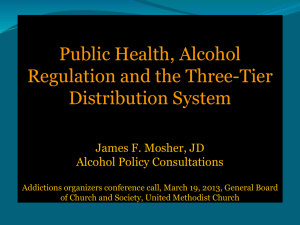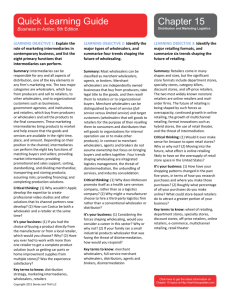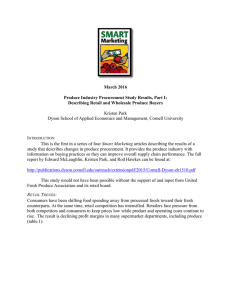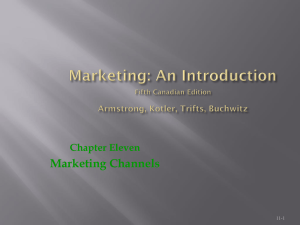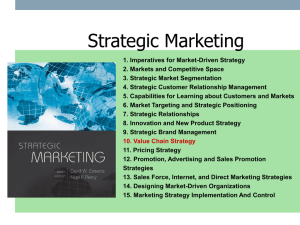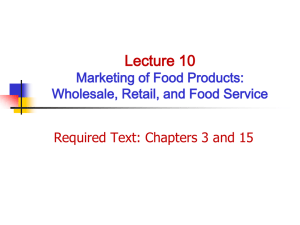Marketing Channels
advertisement
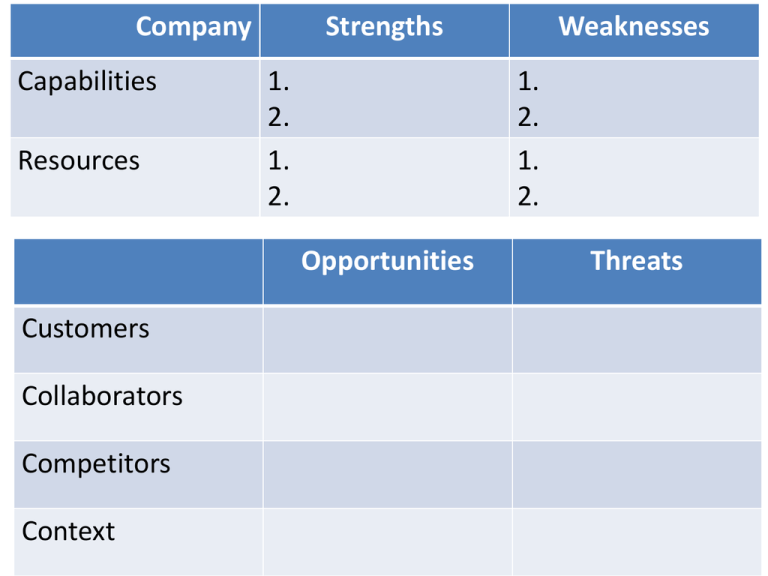
Company Capabilities Resources Strengths 1. 2. 1. 2. 1. 2. 1. 2. Opportunities Customers Collaborators Competitors Context Weaknesses Threats Characteristics of well-written objectives: • Lists a quantified standard of performance. • States goal in measurable terms. • Should be challenging but realistic. • Designates a clear time frame. Forecast Method 3: Ideal target (overweight females, 35-65, college-educated) % who might purchase Metabical in Year 1 & after 4,300,000 4,300,000 4,300,000 4,300,000 4,300,000 30% 5% 1,290,000 1,505,000 1,720,000 1,935,000 2,150,000 % who will buy a second package 60% 774,000 903,000 1,032,000 1,161,000 1,290,000 % of these who will buy a third package 20% 154,800 180,600 Sales 206,400 232,200 258,000 2,218,800 2,588,600 2,958,400 3,328,200 3,698,000 Year 1: Revenue Objective: 2,000,000 monthly packs at $125: Current Market Size = $3,740,000,000 Market Share Objective:~7% $250,000,000 Metabical Takeaways • Economic Value Analysis, Price Elasticity of Demand, and Positioning are intimately related. • Identifying a company’s competitive advantage and external opportunities simplifies marketing mix decisions. • Clear Objectives and Positioning Statements simplify marketing mix decisions, especially price. Marketing Channels (Place & Promotion) Key Learning Points • Marketing Channel Functions & Push vs. Pull • Key factors affecting channel structure & distribution intensity decisions. • Channel leadership, complexity & conflict. • Channel margin arithmetic – revisited. Any intelligent fool can make things bigger, more complex, and more violent. It takes a touch of genius -- and a lot of courage -- to move in the opposite direction. Albert Einstein 5 Natureview Case Key Issues: • What type of product-market growth strategy do the options represent? Do they require pull versus push strategies? Are competitors, retailers and customers the same? • What are or should be the objectives for each option? How do the three options compare with respect to those possible objectives – e.g., revenue, gross margin, required investment, and potential profit? • What are the critical marketing mix capabilities required for each option? Does Natureview possess these capabilities? • How realistic are the sales forecasts for the three options? • What are the strategic pros & cons for each option? What channel management & conflict issues are involved? 6 Marketing Channel Functions Communication, Transaction, Distribution, Service Communication Relationship Management Marketing Research Assortment Matching/ Customizing Negotiation Financing Physical Distribution Product Assembly/ Installation Service 7 One-to-one marketing Market segmentation Customer-centric Marketing Differentiation Product Differentiation Brand-centric Marketing Differentiation Mass marketing Cost Leadership Company Direct Distribution Exclusive-Selective Distribution Selective-Intensive Distribution Intensive Distribution Retailers Consumers 8 Push Strategy • Persuade wholesalers and retailers to carry brands (sales force). • Give brand shelf space & end of aisle displays. • Promote brand in coop advertising with trade promotion & allowances Producer Wholesaler Retailer End Customer At the extreme, Producer has little or no contact with end customer; wholesalers &/or retailers are the target customers who then manage the channel functions. Most consistent with Product Differentiation (Exclusive Distribution) or Cost Leadership (Intensive Distribution) advantage. Tablet makers will also have a tough sell differentiating brands at stores such as Best Buy, where devices sit on shelves with similar models… 9 Pull Strategy • Entice customers to try/prefer your product. • Lure customers from competitive products (e.g., promotional messages & coupons). • Hold & reward loyal customers through advertising reminders, price & quantity discounts, coupons and rebates Producer Wholesaler Retailer End Customer Producer attempts to establish “relationship” with end customer and wholesalers & retailers are collaborators who manage some channel functions. Consistent with Brand-centric Marketing Differentiation (Selective-Intensive Distribution) advantage. Firms pursuing Customer-Centric Marketing Differentiation use direct channels. If you go into an Apple Store, the tablets are front and center, and it's an exciting environment … 10 Discussion Question • Why do you think such a large proportion of the promotional budget is spent on trade promotion? • What are the implications for Natureview… Flare? 11 Trade Relations, Channel Leadership & Conflict • A channel leader is required to coordinate activities in a channel system. • Relative resources, value-added & capability complexity determine which channel member manages & has power in the channel relationship. 12 Complex Channels & Channel Power R&D Lab1 FDA R&D Lab2 GSK Ad Agency TV, Web… Physician Patient R&D Lab3 Insurance Co. R&D Labn Distributor Pharmacy Who Manages the Greatest Complexity & Assumes the Most Valuable Channel Functions? 13 Supermarket Channel Natureview Distributor Supermarkets Consumer Natural Foods Channel S a l e s B r o k e r s Conflict? Natureview Natural Foods Wholesaler Natural Foods Distributor Natural Foods Retailer Consumer 14 Multiple Channels? Conflict? 15 Trade Relations, Channel Leadership & Conflict • A channel leader is required to coordinate activities in a channel system. • Relative resources, value-added & capability complexity determine which channel member manages & has power in the channel relationship. • Mega-retailers and category killers have enormous channel power due to: – Industry consolidation. – Limited shelf space is a key resource. – Scanner data and technology provide a secondary resource and capability category management (ECR, CRP). • Technology can create new channels. • Conflict hurts everyone in the channel but especially those with little power. 16 Collaborators -- Channel Margin Analysis Cases May Require Price-Setting to Intermediaries Planned Prices and Margins for a Software Product Retail Price $400 Retail Price $500 RM 40% Wholesale Price $240 Wholesale Price $300 Manufacturer Price $240 WM 20% GM 50% Manufacturer Price $192 GM goes to 72/192 = 37.5% Cost of Goods Sold $120 Cost of Goods Sold $120 COGS 50% Or reduce COGS 20% to $96 What if you wanted a $400 MSRP? 17 Final Exam Sample Problem: Channel Pricing (K&P, Ch 2, Ex #4) After spending $300,000 for research and development, chemists at Diversified Citrus Industries have developed a new breakfast drink, called Zap, which provides the consumer with twice the amount of vitamin C currently available in breakfast drinks using all natural ingredients. Zap will be packaged in an 8-ounce container and will be introduced to the breakfast drink market, which is estimated at 21 million 8-ounce servings nationally. A major management concern is the lack of funds available for marketing. Accordingly, management has decided to use newspapers (rather than television) to promote Zap in the introductory year and distribute Zap in major metropolitan areas that account for 65 percent of U.S. breakfast drink volume. Newspaper advertising will carry a coupon that will entitle the consumer to receive $0.20 off the price of the first can purchased. The retailer will receive the regular margin and be reimbursed for redeemed coupons by Diversified Citrus Industries. Past experience indicates that for every five cans sold during the introductory year, one coupon will be returned. The cost of the newspaper advertising campaign (excluding coupon returns) will be $250,000. Other fixed overhead costs are expected to be $90,000 per year. Management has decided that the suggested retail price to the consumer for the 8-ounce can should be $0.50. The only unit variable costs for the product are $0.18 for materials and $0.06 for labor. Retailers demand a margin of 20 percent of the suggested retail price and wholesalers a margin of 10 percent of the retailers’ cost. At what price will Diversified Citrus Industries be selling its product to wholesalers? What is the contribution per unit for Zap? What is the break-even unit volume in the first year? What is the first-year break-even share of market? 18 Review Questions • Identify key channel functions associated with communications, transaction, distribution & service. • What factors affect distribution intensity & channel structure decisions? • Identify 3 distinguishing characteristics of a push versus a pull strategy. • What are the challenges associated with using multiple channels? • What determines which channel partner will lead the channel? 19



